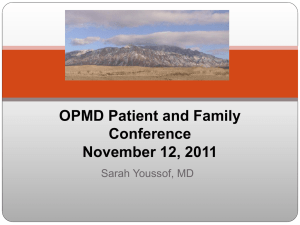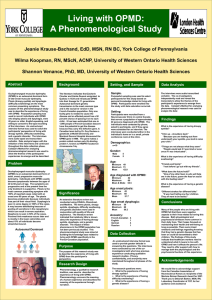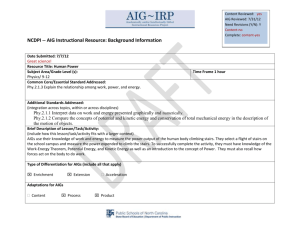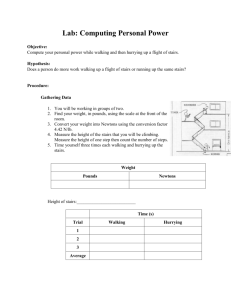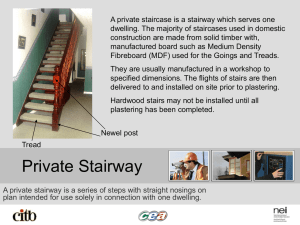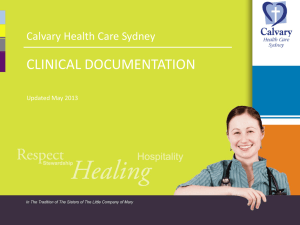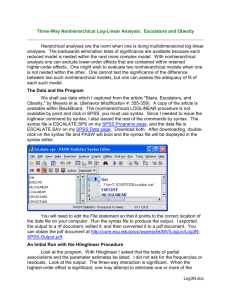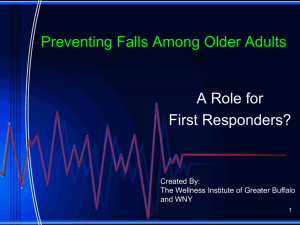OPMD: Physical Therapy and Exercise
advertisement
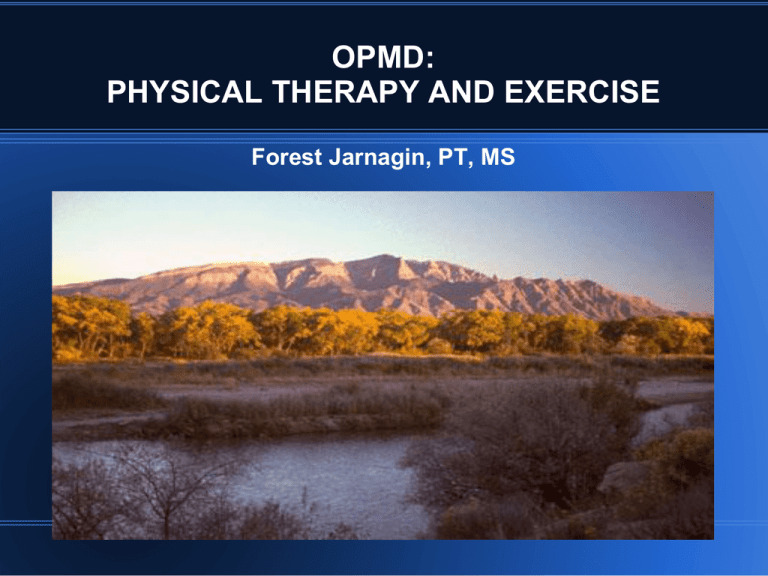
OPMD: PHYSICAL THERAPY AND EXERCISE Forest Jarnagin, PT, MS OBJECTIVES Is it safe to exercise with OPMD? Why exercise? What type of exercise and how often? Adaptations and assistive devices for common mobility problems (time permitting) Is it safe? Traditional concerns • • Overuse and muscle repair • Inability to strengthen Current research • • Human studies • Mouse models of Duchenne's MD Why exercise? Risks associated with aging / lifestyle Loss of muscle mass after 40 Cardiovascular risks Osteoporosis Falls Weight gain with inactivity OPMD Strength loss Slow progression Why exercise? Typical patterns of weakness in OPMD Greater frequency proximal LE vs UE Impact on Walking Balance Sit to stand Stairs Picking up objects from floor / low surfaces What type of exercise? Strength training Cardiovascular STRENGTH TRAINING RESISTANCE TRAINING Machines Free weights Resistance Bands Body weight / anti-gravity Gravity eliminated Active assistive PROXIMAL vs. DISTAL Trunk muscles (abs and spine) Shoulder blade / shoulder girdle Hips / pelvic girdle STRENGTHENING and PROGRESSIVE WEAKNESS MILD TO MODERATE WEAKNESS VS SEVERE WEAKNESS STRETCHING AND RANGE OF MOTION Stretching for comfort Avoiding contractures Over stretch – weak muscles Range of Motion (ROM) Strength Training Determining level of resistance Single repetition maximum (SRM) Best guestimate 50% - 80% or SRM 2-3 sets of 10 – 12 repetitions Fatigue CHALLENGING ACTIVITIES • Sit to stand • Stairs • Picking up objects from floors • Low / overhead surfaces Cardiovascular Exercise TARGET HEART RATE • 70 – 80% of maximum • Maximum = 220 – age DURATION / FREQUENCY • Ideal – 20 – 30 min/day • Target – 20 -30 min 3 x/ week Monitoring Exertion Levels • Borg Rating of Perceived Exertion RPE Options for Cardio Exercise Walk / run Equipment Treadmills / elipticals Stationary bikes / steppers Recumbent options Arm bikes / ergometers POOL EXERCISE Safe environment Supportive Resistive Decreased resistance Cardio-vascular COMBINING STRENGTH AND CARDIO CIRCUIT TRAINING 45 – 55% SRM 30 seconds exercise 5 – 10 sec rest New exercise Pain and Exercise • Delayed onset muscle soreness vs. acute / persistent pain Monitoring pain Never exceed 8 Never increase > 2 points REST AND RECOVERY 48-72 hours between workouts for same muscle groups At least one full rest day per week Strength and cardio same day, alternating Upper and Lower body PACING Recovery within 20 -30 min Breaking activities into shorter segments with frequent rest vs. Pushing to complete with excess fatigue at end Applies equally to exercise and daily activities Exercise and OPMD Is it safe? Yes, with appropriate precautions. Pacing, moderate level, respect pain. Why exercise? – Strengthen, moderate impact of aging and potential other health problems. Possibly slow progression. What type? – Strength and cardio. CHALLENGING ACTIVITIES • Sit to stand • Stairs • Picking up objects from floors • Low / overhead surfaces Modifications Modifications Stairs, Rails and Ramps Rails on stairs Vertical rails / grab bars at doorways Ramps – thinking ahead to wheelchairs One inch of rise per foot of run “Rest” areas every 5 feet Modifications / Adaptations Moving frequently used items to counter / middle shelves Reachers Shower chairs Grab bars Mobility Devices Canes Crutches (Standard, Forearm) Walkers (std., 2 wheeled, 4-wheeled, seats) Wheelchairs and Scooters Considerations in Selecting Primary usage Weight and ease of transport Transport devices / costs Insurance and frequency of replacement
